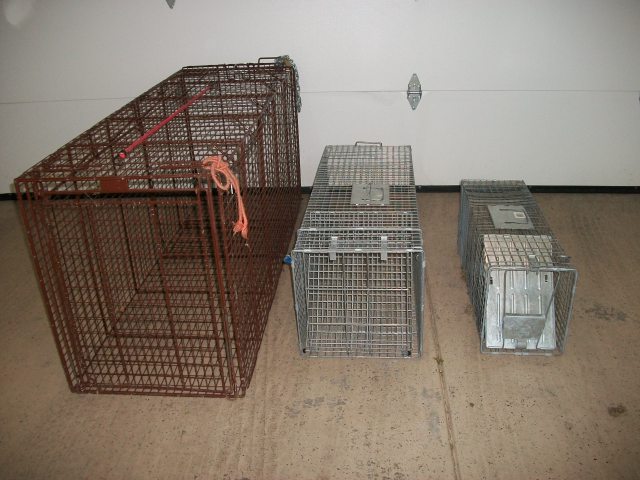
Size Comparison (from left to right)
Tru Catch large dog trap 22″ x 28″ x 60″
Havahart large raccoon trap 15″ x15.5″ x 42″
Havahart small trap 10″ x 12.5″ x 32″ (not recommended for dogs)
You’ve decided that you are prepared to accept the risk and expense of trying to trap your shy lost dog. If you aren’t aware of the risks or financial commitment involved, please read Part 9 of the series before you continue.
Choose your humane trap wisely. You may only get one shot at trapping your dog so make sure you set yourself up for success. You may be limited to what is available to rent or buy in your area, but if at all possible, follow these guidelines.
1. Size: Always choose a trap that your dog can easily stand up and turn around in. Larger is better than smaller. Some dogs won’t mind entering a small enclosed space, but some will: especially those that have been lost a long time or are distrustful and will want an escape route.
2. Doors: If at all possible choose a trap with a front and rear door. The rear door is used to access the bait and it is very handy. Otherwise you will physically have to crawl into a large dog trap, very awkward – especially on rainy or snowy days. With a smaller trap, you will need to have very long arms, or some kind of tongs to position the bait. The rear door can also help your dog become comfortable with the trap, and you can allow him access from both sides and use it as a shelter (more on this later).
3. Design: There are some large coyote traps on the market for a very cheap price at farm supply stores. Don’t waste your money and/or endanger your dog with these. They are flimsy and poorly designed. The trip plate is set in the middle of the trap instead of almost to the back, where it should be. We have heard of many incidences where the dog begins to enter but then gets suspicious. He has already stepped on the plate (because it is in the middle) and then starts to back out. The door isn’t all the way down so he manages to push his way out, bends the trap all apart, and is thereafter scared to go near a humane trap. Don’t risk it! Remember, you will have one shot at this. If your dog gets scared, then you will have to start all over with a new plan that doesn’t involve a humane trap.
4. Functionality: The trap should operate as smoothly and quietly as possible. Give it a few test runs by setting it and tripping it with a stick. If it isn’t working properly, don’t use it. The wire shouldn’t be all bent out of shape. When it is closed, and a dog inside, the dog shouldn’t be able to push his nose against the door and get it open enough to get his head or neck partway out. He could injure himself and panic.
There are some excellent brands of traps including TruCatch and Tomahawk. Havahart makes a large raccoon trap that is suitable for catching a small dog, probably up to about 20 pounds. Heart of the Earth Animal Equipment has a good website with a large selection of live traps. Again, make sure you choose a trap large enough for the dog you are trying to catch.
If you are renting a trap from a shelter or animal control facility, be prepared to pay a deposit, a rental fee and sign a liability waiver. In smaller communities, you might also check with your local police department or town office. If they are in charge of animal control for the area, you may be able to rent a trap from them. The large raccoon trap from Havahart is available at many farm supply stores. If you have to purchase a trap online, start early. Traps are large and cumbersome to ship, so substantial shipping charges usually apply and delivery may be slow.
Next, we will talk about locating your trap for the best chance of success. Click here to go to Part 11.
Our tips, ideas and articles are based on information gathered from thousands of successful lost dog recoveries. Any advice or suggestions made by Lost Dogs of Wisconsin/Lost Dogs Illinois is not paid-for professional advice and should be taken at owner’s discretion.
